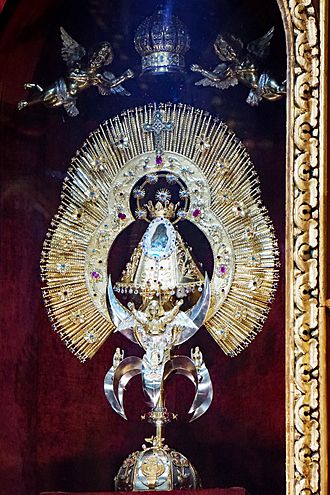Virgen de los Angeles facts for kids
Quick facts for kids Virgen de los Angeles Day |
|
|---|---|

Our Lady of the Angels at the main altar of the Basílica de Nuestra Señora de los Ángeles
|
|
| Observed by | Costa Rica |
| Type | Historical |
| Significance | Celebration of Costa Rica's patron saint |
| Date | 2 August |
| Next time | 2 August 2026 |
| Frequency | annual |
The Virgen de los Angeles (Virgin of the Angels) is like a special protector for Costa Rica. People also call her La Negrita, which means 'The Little Black One'. Virgen de los Angeles Day is a holiday in Costa Rica where people celebrate her.
Contents
What is Virgen de los Angeles Day?
This special day celebrates the Virgen de los Angeles, also known as La Negrita. She is considered the patron saint of Costa Rica. A patron saint is like a special guardian or protector for a country or group of people.
The Story of La Negrita
The story of La Negrita began a long time ago, on August 2, 1635. A local woman found a small statue of the Virgin Mary. This statue was less than a meter tall and looked like it might have been made by native people or people of mixed race.
The story says that when the woman tried to take the statue home, it magically appeared back where she found it, not just once, but twice! Because of this amazing event, the people in the town decided to build a special place of worship around where the statue was found.
La Negrita's Special Home
In 1824, the Virgin was officially declared Costa Rica's patron saint. Today, La Negrita lives in a beautiful church called the Basílica de Nuestra Señora de los Ángeles in Cartago. She sits on a platform made of gold and decorated with jewels.
The Annual Pilgrimage
Every year, on August 2nd, which is the anniversary of the statue's discovery, thousands of people make a special journey. These people are called pilgrims. They walk about 22 kilometers (about 13.5 miles) from San José to the basilica in Cartago. People come from all over Costa Rica and even from other countries to take part in this walk.
Many of these pilgrims show their deep faith by completing the last few hundred meters of their journey on their knees. This act is a form of penance, which means showing sorrow for past actions or making a sacrifice for a special intention. The basilica is a popular place for both tourists and local people to visit.
In 2014, a copy of the La Negrita statue was placed in the Vatican City, which is the home of the Pope.
See also
 In Spanish: Virgen de los Ángeles (Costa Rica) para niños
In Spanish: Virgen de los Ángeles (Costa Rica) para niños

